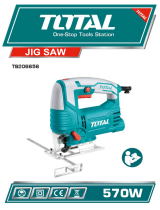
3
b) Do not use the power tool if the switch does not turn it on and off. Any
power tool that cannot be controlled with the switch is dangerous and must
be repaired.
c) Disconnect the plug from the power source and/or the battery pack from
the power tool before making any adjustments, changing accessories,
or storing power tools. Such preventive safety measures reduce the risk of
starting the power tool accidentally.
d) Store idle power tools out of the reach of children and do not allow
persons unfamiliar with the power tool or these instructions to operate the
power tool. Power tools are dangerous in the hands of untrained users.
e) Maintain power tools. Check for misalignment or binding of moving parts,
breakage of parts and any other condition that may affect the power tool’s
operation. If damaged, have the power tool repaired before use. Many
accidents are caused by poorly maintained power tools.
f) Keep cutting tools sharp and clean. Properly maintained cutting tools with
sharp cutting edges are less likely to bind and are easier to control.
g) Use the power tool, accessories and tool bits, etc. in accordance with
these instructions, taking into account the working conditions and the work
to be performed. Use of the power tool for operations different from those
intended could result in a hazardous situation.
5) SERVICE
a) Have your power tool serviced by a qualified repair person using only
identical replacement parts. This will ensure that the safety of the power tool
is maintained.
Electrical Safety
The electric motor has been designed for one voltage range only. Always check that
the power supply corresponds to the voltage on the rating plate. 220–240 V AC
means your tool will operate on alternating current. Operation at a voltage outside this
range can cause loss of power and can result in overheating. All DEWALT tools are
factory tested; if this tool does not operate, check the power supply. Your DEWALT
tool is double insulated, therefore no earth wire is required.
• Young children and the infirm. This appliance is not intended for use by young
children or infirm persons without supervision.
– This appliance is not intended for use by persons (including children) with
reduced physical, sensory or mental capabilities, or lack of experience and
knowledge, unless they have been given supervision or instruction concerning
use of the appliance by a person responsible for their safety.
– Children should be supervised to ensure that they do not play with the appliance.
• Replacement of the supply cord. If the supply cord or plug is damaged, it must
be replaced by the manufacturer or an authorised D
EWALT Service Centre in
order to avoid a hazard.
Extension Cords
CAUTION: Use only extension cords that are approved by the country’s Electrical
Authority. Before using extension cords, inspect them for loose or exposed wires,
damaged insulation and defective fittings. Replace the cord if necessary.
Additional Specific Safety Rules for Jigsaws
• Hold power tool by insulated gripping surfaces, when performing an operation
where the cutting accessory may contact hidden wiring. Cutting accessory
contacting a “live” wire may make exposed metal parts of the power tool “live”
and could give the operator an electric shock.
• Use clamps or another practical way to secure and support the workpiece
to a stable platform. Holding the work by hand or against your body leaves it
unstable and may lead to loss of control.
• Allow the motor to come to a complete stop before withdrawing the blade
from the kerf (the slot created by cutting). A moving blade may impact the
workpiece causing a broken blade, workpiece damage or loss of control and
possible personal injury.
• Keep handles dry, clean, free from oil and grease. This will enable better
control of the tool.
• Keep blades sharp. Dull blades may cause the saw to swerve or stall under
pressure.
• Clean out your tool often, especially after heavy use. Dust and grit containing
metal particles often accumulate on interior surfaces and could create an electric
shock hazard.













